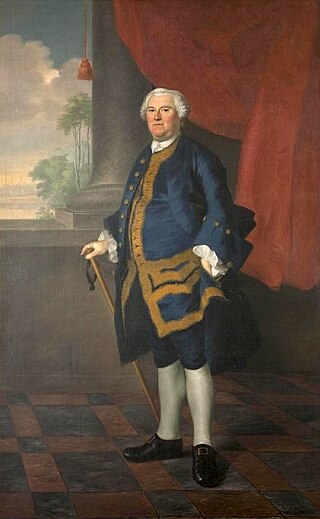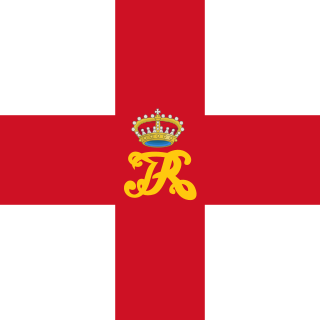
The Massachusetts Bay Colony, more formally the Colony of Massachusetts Bay, was an English settlement on the east coast of North America around the Massachusetts Bay, the northernmost of the several colonies later reorganized as the Province of Massachusetts Bay. The lands of the settlement were in southern New England, with initial settlements on two natural harbors and surrounding land about 15.4 miles (24.8 km) apart—the areas around Salem and Boston, north of the previously established Plymouth Colony. The territory nominally administered by the Massachusetts Bay Colony covered much of central New England, including portions of Massachusetts, Maine, New Hampshire, and Connecticut.

Sir Ferdinando Gorges was a naval and military commander and governor of the important port of Plymouth in England. He was involved in Essex's Rebellion against the Queen, but escaped punishment by testifying against the main conspirators. His early involvement in English trade with and settlement of North America as well as his efforts in founding the Province of Maine in 1622 earned him the title of the "Father of English Colonization in North America," even though Gorges himself never set foot in the New World.

Benning Wentworth was an American merchant and colonial administrator who served as the governor of New Hampshire from 1741 to 1766. While serving as governor, Wentworth is best known for issuing several land grants in territory claimed by the Province of New Hampshire west of the Connecticut River, which led to disputes with the neighboring colony of New York and the eventual founding of Vermont.

The Province of New Hampshire was a colony of England and later a British province in New England. The name was first given in 1629 to the territory between the Merrimack and Piscataqua rivers on the eastern coast of North America, and was named after the county of Hampshire in southern England by Captain John Mason, its first named proprietor. In 1776 the province established an independent state and government, the State of New Hampshire, and joined with twelve other colonies to form the United States.

The Province of Maine refers to any of the various English colonies established in the 17th century along the northeast coast of North America, within portions of the present-day U.S. states of Maine, New Hampshire, and Vermont, and the Canadian provinces of Quebec and New Brunswick. It existed through a series of land patents made by the kings of England during this era, and included New Somersetshire, Lygonia, and Falmouth. The province was incorporated into the Massachusetts Bay Colony during the 1650s, beginning with the formation of York County, Massachusetts, which extended from the Piscataqua River to just east of the mouth of the Presumpscot River in Casco Bay. Eventually, its territory grew to encompass nearly all of present-day Maine.

Captain John Mason (1586–1635) was an English sailor and colonist who was instrumental to the establishment of various settlements in colonial America. Born in 1586 at King's Lynn, Norfolk, and educated at Peterhouse, Cambridge. In 1610, he was appointed by James I to help reclaim the Hebrides. As a reward, he was granted exclusive fishing rights in the North Sea. This was ignored by the Dutch and he was treated as a pirate by the Scots. In 1615, he was arrested, but soon released after the seizure of his ship. He was appointed the second Proprietary Governor of Newfoundland's Cuper's Cove colony in 1615, succeeding John Guy. Mason arrived on the island in 1616 and explored much of the territory. He compiled a map of the island and wrote and published a short tract of his findings.

Joseph Dudley was a colonial administrator, a native of Roxbury in Massachusetts Bay Colony, and the son of one of its founders. He had a leading role in the administration of the Dominion of New England (1686–1689) which was overthrown in the 1689 Boston revolt. He served briefly on the council of the Province of New York where he oversaw the trial which convicted Jacob Leisler, the ringleader of Leisler's Rebellion. He then spent eight years in England in the 1690s as Lieutenant-Governor of the Isle of Wight, including one year as a Member of Parliament for Newtown. In 1702, he returned to New England after being appointed governor of the Province of Massachusetts Bay and Province of New Hampshire, posts that he held until 1715.

The Dominion of New England in America (1686–1689) was an administrative union of English colonies covering all of New England and the Mid-Atlantic Colonies with the exception of the Delaware Colony and the Province of Pennsylvania. The region's political structure was one of centralized control similar to the model used by the Spanish monarchy under the Viceroyalty of New Spain. The dominion was unacceptable to most colonists because they deeply resented being stripped of their rights and having their colonial charters revoked. Governor Sir Edmund Andros tried to make legal and structural changes, but most of these were undone and the Dominion was overthrown as soon as word was received that King James II had left the throne in England. One notable change was the introduction of the Church of England into Massachusetts, whose Puritan leaders had previously refused to allow it any sort of foothold.
Thomas Danforth was a politician, magistrate, and landowner in the Massachusetts Bay Colony. A conservative Puritan, he served for many years as one of the colony's councilors and magistrates, generally leading opposition to attempts by the English kings to assert control over the colony. He accumulated land in the central part of the colony that eventually became a portion of Framingham, Massachusetts. His government roles included administration of territory in present-day Maine that was purchased by the colony.

William Stoughton was a New England Puritan magistrate and administrator in the Province of Massachusetts Bay. He was in charge of what have come to be known as the Salem Witch Trials, first as the Chief Justice of the Special Court of Oyer and Terminer in 1692, and then as the Chief Justice of the Superior Court of Judicature in 1693. In these trials he controversially accepted spectral evidence. Unlike some of the other magistrates, he never admitted to the possibility that his acceptance of such evidence was in error.
New Hampshire is a state in the New England region of the northeastern United States. During the American Revolution, it was one of the Thirteen Colonies that revolted against British rule. One of the smallest U.S. states in area and population, it was part of New England's textile economy between the American Civil War and World War II. Since the 20th century, the state has been known for its presidential primary, outdoor recreation, its educational boarding schools, and being part of the biotech industry.

George Vaughan may be best known for being Lieutenant Governor of the Province of New Hampshire for only one year. A graduate of Harvard College in 1696, he was also at various times a merchant, colonel of militia, agent for the province to England, and counsellor.

The 1689 Boston revolt was a popular uprising on April 18, 1689 against the rule of Sir Edmund Andros, the governor of the Dominion of New England. A well-organized "mob" of provincial militia and citizens formed in the town of Boston, the capital of the dominion, and arrested dominion officials. Members of the Church of England were also taken into custody if they were believed to sympathize with the administration of the dominion. Neither faction sustained casualties during the revolt. Leaders of the former Massachusetts Bay Colony then reclaimed control of the government. In other colonies, members of governments displaced by the dominion were returned to power.
Walter Neale was an English military officer and an explorer and colonial administrator in the territory of New England that later became New Hampshire.
Richard Vines was an English colonial explorer of northern New England, and an early administrator and deputy governor of the Province of Maine.
William Wentworth (1616–1696/7) was a follower of John Wheelwright, and an early settler of New Hampshire. Coming from Alford in Lincolnshire, he likely came to New England with Wheelwright in 1636, but no records are found of him in Boston. When Wheelwright was banished from the Massachusetts Bay Colony for his role in the Antinomian Controversy, he established the settlement of Exeter, New Hampshire, and Wentworth followed him there and then to Wells, Maine. After Wheelwright left Wells for Hampton, New Hampshire, Wentworth went to Dover, New Hampshire, and this is where he lived the remainder of his life. He was the proprietor of a sawmill, and held several town offices, but is most noted for being an elder in his Dover church for nearly 40 years. He had 11 children with two wives, and has numerous descendants, including many of great prominence.

David Thompson or David Thomson (1588–1628) was the first governor of Massachusetts under the 1622 Council for New England grant to Robert Gorges. He also held the 6000-acre 1622 Piscataqua grant under the Council and is considered the founder and first non-native settler of New Hampshire. In addition, Thomson was granted a patent for Thompson Island in Boston Harbor which to this day bears his name. According to Burke's Landed Gentry (2010) the Thomsons of Corstorphine are direct descendants of a great-grandson of King Robert II, namely, Sir Thomas Stewart, Master of Mar.
Pannaway Plantation was the first European settlement in what is now currently the state of New Hampshire. By 1630, the plantation was abandoned, and the settlers moved to Strawbery Banke in what is now Portsmouth. Pannaway Plantation was settled on land that is now in Odiorne Point State Park in the town of Rye.

























